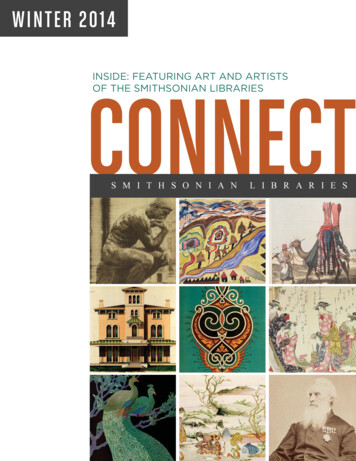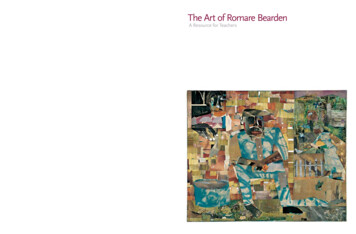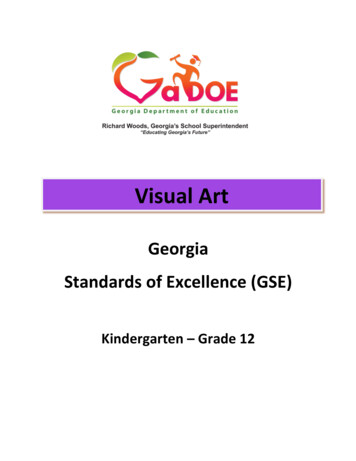
Transcription
WINTER 2014INSIDE: FEATURING ART AND ARTISTSOF THE SMITHSONIAN LIBRARIESCONNECTS M I T H S O N I A NL I B R A R I E S
IN THIS ISSUEDIRECTOR’S CORNER .3NEWSLibraries Acquires Salviani Book .4da Vinci's Flight of Birds Lands at the Libraries. 4Comics Featured on Smithsonian Channel . 4Tumblr Takes Flight . 4Images on Art.com .5Introducing OneSearch . 5Courses Published on iTunes U .5STRIKE A POSE: LIBRARIES CELEBRATES FALL FASHION WEEKRobes et Femmes .6Liberating Fashion: Poiret’s Plates .7Turning Heads in 1916 and 1917 .7SMITHSON AT THE SMITHSONIANLibrary Holdings Connect Generations of Smithson’s Family .8The James Smithson Library .8James Smithson’s Personal Library .9EXHIBITIONSField of Vision Exhibition Opens .10An Art Library Internship .10Libraries Unveils Whales: From Bone To Book .11INTERNS & SCHOLARS MAKE A DIFFERENCESummer Interns .12Jennifer Himmelreich .12Joseph Dimuro .13Lacey Baradel .14GIFTS .15FEATURE STORYSpotlight: Art & Artist Files .16EVENTSA Celebration of Authors .18Wikipedia Loves Libraries 2013 .18Understanding Asian Papers and their Applications in Paper Conservation Workshop .19Preservation Matters!.19Ghana Night.19Unlocking Taxonomic Literature II using Linked Open Data .19BIODIVERSITY HERITAGE LIBRARYBHL at the American Library Association Annual Meeting 2013 .20BHL Launches First iBook. 20BHL Marketing and Virtual Reference Interns . 21NEScent-EOL-BHL Research Sprint. 21Digital Collections Report Features Biodiversity Heritage Library . 21THE LIFE OF THE NATURAL HISTORY LIBRARIES .222
DIRECTOR’S CORNERDear Friends,When we reflect back on 2013, we realize that our accomplishments definitely outweighed our challenges. Budgetsequestration, government shutdown, the sad and unexpected passing of staff member Rita O’Hara – werebalanced with much we can celebrate. Just to name a few: Launched the OneSearch capability for Smithsonian staff to be able to search across all of the Libraries’offerings (online catalog, electronic databases and journals, etc.) in a single search; Hosted 10 events, raised 125% of the annual fund-raising goal; Answered nearly 25,000 reference questions, circulated 32,000 library items for the first time (not counting renewals), handled 8,200interlibrary loan items, and supported 157,000 database searches; Launched a new strategic planning effort and began work on a pilot project to offer e-books to Smithsonian research staff; Completed renovations in the Botany, Fishes and Mammals Libraries in the Natural History Museum, moved the SERC Library intointerim space, moved Libraries Administration and Central Services into newly renovated spaces; Launched BHL Africa and began work on BHL Singapore; increased numbers of digital books in the Libraries Cultural HeritageLibrary by 31%; Placed 10 educational courses on iTunes U and opened exhibition “Whales: Bone to Book;” touched 6,487 people with educationaltours, workshops and presentations.In this issue, you’ll meet some of our Resident Scholars and Interns. Scholars research and inform us about the specialities of our collectionsand interns develop and apply their skills to expand our programs. These young people continue to amaze us and we’re delighted to give themextraordinary experiences. Our librarians locate valuable items to add to our collections as they serve our users, and our digitizing efforts aresharing our collections with the world (over one million visitor website sessions last year!). Our public programs and events expand ouraudiences. None of this would happen without the support of our many donors and friends, for which we are overwhelmingly grateful.The Smithsonian Libraries wishes you happy reading experiences and good fortune in 2014!Nancy E. GwinnDirector(Below: Haru no Fuji by Hokusai Katsushika, 1760-1849 (Suehiroan, 1803). Courtesy of Smithsonian Libraries Freer & Sackler Library.)3
NEWSLIBRARIES ACQUIRES SALVIANI BOOKThe Joseph F. Cullman 3rd Library of Natural History recently acquired Ippolito Salviani’sAquatilium animalium historiae (Rome, 1554), a classic, foundational work on fishes. Thebook is one of three 16th-century works that established ichthyology as a modern science.The Libraries holds the other two – Belon’s De aquatilibus (1553, a Latin translation of hisHistoire de la nature des estranges poissons marins, 1551) and Rondelet’s Libri de piscibusmarinis (1554) – and has now completed the trio. The Aquatilium animalium historiae isa tremendous asset for the National Museum of Natural History’s curators in the Divisionof Fishes, who advised on the purchase.A professor of medicine at the University of Rome and physician to several Popes, Salviani(1514-1572) collected fishes in Roman markets and incorporated anatomical notes tosupport his systematic studies, correcting and expanding the works of the ancient authors(Aristotle, Pliny, et al.). The book first presents synoptic tables of fish species – theircharacteristics, names in multiple languages, and source information in the classicalauthors; the main text provides in-depth descriptions of the fishes Salviani examined, withillustrations. Ninety-three species of fishes and cephalopods are depicted in the plates,with 18 of them new to the science of the time. Unlike Belon and Rondelet, Salviani was the first to limit the concept of fish tosolely aquatic vertebrates, excluding beavers, otters, and sea monsters of various kinds that had previously been included.The work is the earliest zoological book illustrated with copper-engraved plates – drawn by Aretinus, engraved by Lafréry andBeatrizet – far more suitable than the woodcuts typical of the period for reproducing in fine, silvery lines the visual effect of fishscales and the delicate fins. The great ichthyologist Bashford Dean (1867-1928) noted that the plates exceed in accuracy andbeauty any others for the next 100 years.4da Vinci's Flight of BirdsLands at the LibrariesComics Featured onSmithsonian ChannelOne of Italy's greatest treasures,Leonardo da Vinci's Codex on theFlight of Birds, found safe refuge inthe National Museum of Air & SpaceLibrary’s rare book room until itwas exhibited at the museum fromSeptember 13 to October 22. Theextraordinary document, created ca.1505, shows da Vinci's interest inhuman flight by exploring bird flightand behavior. It includes sketches anddescriptions of devices and aerodynamicprinciples related to mechanical flightthat predate the invention of the airplaneby 400 years.In July, the SmithsonianChannel filmed the Libraries’ collectionof the first Wonder Woman comicsat the Dibner Library of the Historyof Science and Technology. TheWonder Woman comics are one ofseveral artifacts selected in tandemwith the recently released book, TheSmithsonian's History of America in101 Objects, by Richard Kurin, UnderSecretary for History, Art, andCulture. The Smithsonian Channeldocumentary series features uniqueitems from around the Institution thattell the story of America's history,based on Kurin's book. Lilla Vekerdy,Head of Special Collections, as well astwo surprised museum visitors werepart of the filming.Tumblr Takes FlightWhat better way to bring hiddencollections to life than through animationon the microblogging platform, Tumblr?Eight of Data Manager Richard Naples’sposts on the Smithsonian Libraries’Tumblr blog, Turning the Book Wheel,have gone viral, leading to a dramaticincrease of followers from 828 in May toover 30,000 (and counting) today! Viewthe viral posts (which have been likedor reblogged over 75,000 times), madefrom captivating pages of books that arecenturies old:smithsonianlibraries.tumblr.com.
IMAGES ON ART.COMEver come across a Smithsonian Libraries image that you wish you could frame? Our Galaxy of Images contains thousands of beautiful imagesscanned from our collection. Now’s your chance to own and display a treasured piece of the Libraries in your home or office!In collaboration with Smithsonian Enterprises, Smithsonian Libraries released several images to Art.com which are available for purchase in printform. The images, in subjects ranging from early 20th century costumes and seed catalogs to natural history and aviation, vary in price from 29.99to 299.99 depending on size and quality. Check them out at the Art.com website. Happy shopping!John Gardiner & Co.,Seed Annual, 1896Gazette du Bon Ton, 1924-1925, Plate 20: Rougeet Or, Illustration by George Barbier (1882-1932)John A. Salzer Seed Co., Spring 1898Introducing OneSearchThe Smithsonian Libraries is always working to improve ourusers’ research experiences. We were pleased recently to launchOneSearch, our newest and most powerful research tool.OneSearch opens the digital front door to the Libraries’ resourcesand beyond. It offers a single search box that taps into a widerange of our research materials – the library catalog, journaland newspaper articles (many in full-text), databases, andmuch more. It even provides access to records and data fromsources outside the Libraries’ collections. By bringing so manyresources together in one place, OneSearch helps users easilyfind and access extensive research materials, saving time andincreasing efficiency. OneSearch is available to all Smithsonianstaff, including researchers, curators, visiting scholars, fellowsand interns, as well as library visitors.Visit one of our library branches to use this comprehensive newtool: library.si.edu/about/visiting-libraries.COURSES PUBLISHED ON iTUNES UThe Libraries completed ten courses for iTunes U that focus on topics in early aviation and space history. Three courses are available now: TheGreat Moon Hoax, Early Aviation and the Media, and How Things Fly: Parts of an Aircraft in the World War I Period. More courses will be rolledout during the first half of 2014 with additional topics related to transportation: Women in Aviation, Worldwide Aircraft Design andExperimentation in Pre-World War I, Ballooning and Airship Dirigibles: Lighter-than-air Aircraft History, Military Aviation in World War I, EarlyRocketry Development, The Development of the Automobile in the 19th and 20th Centuries, and Railroad Development in the 19th and 20thCenturies.For students, the courses include vocabulary and guided questions to help them process more difficult materials. For teachers, the coursesinclude learning goals, common core standards for grades 6-12, national history standards, and a guided-inquiry section that suggests how thecourses and materials can be effectively used in the classroom or school library. They are designed to be self-paced experiences, and it is up to theteacher or student to decide which parts of the course they use.The courses are built around library materials from the Galaxy of Images and the Smithsonian Digital Library, supplemented with additionalresources from the Smithsonian Channel, Smithsonian magazine, Air and Space magazine, and NASA materials.Congratulations to interns Maggie Lisman and Kari Dalane who developed the courses!5
STRIKE A POSE: LIBRARIES CELEBRATES FALL FASHION WEEKHighly stylized illustrations by Enrico Sacchetti.Robes et FemmesElizabeth Broman, Librarian Cooper Hewitt National Design LibraryNew York Fashion Week is held in February and September of each year in New York City.The Special Collections of the Cooper- Hewitt National Design Library in New York havealways been a great research resource for people working in the fashion and related industries.One example is a rare fashion title Robes et Femmes, published in 1913 by the Italian designerEnrico Sacchetti (1877-1967).Sacchetti was an illustrator, writer, fashion designer, caricaturist, and commercial artist.Sacchetti collaborated with Marinetti, the Father of Futurism, on his magazine Poesia, inParis, where he worked as a fashion illustrator immediately before World War I. At theoutbreak of the war he returned to Italy, where he worked as a propaganda artist, magazineand book illustrator, and designed postcards and posters. In his long career, he is well knownfor an illustration and graphic style that often crossed the borders between portraiture andcaricature.Robes et Femmes was a satirical look at the avant-garde designs of Paul Poiret and Paul Iribe’siconic Les Robes de Paul Poiret racontées par Paul Iribe (1908). Note the exaggerated poses andfigures of the models, and the elongated necks and shoulders shown here. Sacchetti’sillustrations, which depict feathers, furs, turbans and tunic dresses, resemble Poiret’s designsof the time. The cover and 13 plates are hand-colored lithographs which were published inlimited edition portfolios of 300 numbered copies.6
LIBERATING FASHION: POIRET’S PLATESJen Cohlman Bracchi, Librarian Cooper-Hewitt National Design LibraryThis fashion plate from Les Robes De Paul Poiret (1908) is one of eleven illustrations, all recentlyscanned and now available for your viewing pleasure. Poiret is often credited with liberatingwomen from the body-constricting corsets popular during the Victorian and Edwardian eras(1837-1910).Dress reformers had advocated for classical-style high waistlines as early as the 1880s, but it wasPoiret’s beautifully commissioned album that most successfully promoted this idea, inspiring arevolution in fashion. Designing free-flowing silhouettes that hearkened the neo-classical styleof late 18th-century France and using innovative fabric-draping techniques, his designsconformed more to natural body shapes that continue to characterize fashion to this day.Illustrated by artist Paul Iribe using the labor-intensive hand-stenciling technique of pochoir,this book was expensive to produce and only 250 copies were published. Poiret distributedthem for free to select clients as unique marketing tools.Poiret inscribed the Cooper-Hewitt Library’s copy with these words: “A Monsieur Max Meyer,un Américain bien pausière, qui aime et comprené touts les belles choses. Paul Poiret.” ThisMax Meyer was likely the later fashion industry leader and president of New York’s FashionInstitute of Technology, who would have been a young designer at the time of Poiret’s gift,working for high-end American womenswear companies like A. Beller and Co.Les Robes De Paul Poiret racontées par Paul Iribe. (1908)TURNING HEADS IN 1916 AND 1917Alexia MacClain, Library TechnicianNational Museum of American History LibraryWondering what the styles and trends were almost a century ago? This Bellas Hess & Co. trade catalog givesus an idea of what fashion was like ninety-eight years ago. The Bellas Hess & Co. Fall and Winter Catalogue No.74 is from the seasons of 1916-1917. It includes a variety of clothing and accessories such as dresses, blousesand skirts, suits, hats, and more.Illustrated on the first few pages are ladies’ suits. According to its description on the opposite page, it had aflared skirt and a semi-fitted coat flared below the waist. The coat was lined with satin and fastened with velvetbuttons and loops. Priced at 32.95, it was available in several colors–wine, plum, black, or green (Image 1).Image 1The catalog also illustrates dresses and evening gowns. The evening gown was made of Satin Charmeuse. Asdescribed on the opposite page, “the corsage has a surplice drapery of Brussels net with a touch of netembroidered in gold and pastel colored threads, and a spray of pastel rose buds and velvet foliage.” The sleevesmatched the front and were made of gold embroidered net. There was a cluster of rose buds at the waist, andthe skirt fell in “full graceful folds” with a ruffle of goldembroidered net at the bottom. It was priced at 16.98and available in light blue, pink, or black (Image 2).Also advertised in this catalog are hats. Some are trimmed with roses and green foliagewhile ribbon or ostrich plumes decorate others. Many of the hats have one thing incommon–velvet (Image 3).Fall and Winter Catalogue No. 74 is located in the Trade Literature Collection at theNational Museum of American History Library. Interested in more fashion from the1916-1917 seasons? Visit our Galaxy of Images for more pages from this catalog:sil.si.edu/imagegalaxy.Image 2Image 37
SMITHSON AT THE SMITHSONIANLIBRARY HOLDINGS CONNECTGENERATIONS OF SMITHSON’S FAMILYA Smithson Visit to the Smithsonian Sophie Enstone (neé Smithson)Smithson: such a simple surname. The surname I have had for the vast majority of my life.My British school students found the pronunciation particularly tricky when preceded with a‘Miss’ in my unmarried days. Every booking would be awkward and I often heard theclarification clause: “How do you spell that?” The number of times I had to explain that I wasthe “son” of a “smith” – but to no avail.Yet, I was alerted to the significance of my surname by my paternal grandmother, SusannaSmithson, the family genealogist. She mentioned the Smithsonian Institution and how wewere directly, yet somewhat distantly, related to the founder, James Smithson. From a youngage, it became a life-time ambition of mine to visit the Institution and personally witness thelegacy that my distant relative had left behind.My husband and I took it upon ourselves to visit Washington D.C. at the end of August thisyear, and if I were to choose just one word to describe my feelings towards all that I observed,it would have to be: sensational. Walking through what I can only describe as a Smithsonmicrocosm suddenly made me feel so proud of my family history, no matter how difficultsome may find the pronunciation of my former surname.An exclusive tour allowed us to examine copies of James Smithson’s Will, in the flesh, and we viewed a large number of the founder’s possessionsin the libraries and the archives. An architectural walk-through of the Smithsonian Castle allowed for a historic excursion to the early days ofthe Institution. Although I had read on the internet that the Smithsonian Institution is the largest group of museums in the world, I onlyappreciated the scope of what this meant by personally visiting Washington D.C.Though there are several questions left unanswered relating to James Smithson’s choices and decisions, one thing is for sure: he wanted to create,in his words, “an establishment for the increase and diffusion of knowledge.” Walking through the many museums in Washington D.C., onecertainly concludes that his ambition has truly been fulfilled. Now back in the U.K., at the start of a new academic year, I can only hope tocontinue to achieve what my ancestor began: “increase and [diffuse] knowledge” among the next generation of my students. I just wish I hadkept my paternal surname.THE JAMES SMITHSON LIBRARYLeslie K. Overstreet, Curator of Natural-History Rare Books Joseph F. Cullman 3rd Library of Natural HistoryJames Smithson (c.1765-1829), a gentleman-scientist and founder of the Smithsonian Institution, included hislibrary in his bequest to the United States, and those books now reside in the vault of the Smithsonian Libraries’Joseph F. Cullman 3rd Library of Natural History.When Sophie and Michael Enstone visited in August 2013 we were delighted to welcome them with a display from her distant relative’s library.We filled the four reading-room tables with books and journal articles reflecting Smithson’s interests in the chemical analysis of minerals andmineral collecting, including many that were inscribed to him by their authors, and we discussed the ways in which they illuminate the scienceand the intellectual networks of the period. On the more personal side we included a variety of Smithson’s books of travel narratives, guides fortourists in Holland and the Alps, pamphlets about popular museum exhibitions, auction catalogues, and his copy of the best-selling cook-bookof his day that bears a list of favorite recipes in his own hand.We also showed her that most of Smithson’s books have only a “temporary” sewing structure with paper wrappers, just as he bought them frombooksellers, rather than being properly bound in hard covers. Even as late as the early 1800s, books were not commonly sold in what weconsider a finished form; the material and style of the covers were up to the purchaser to select (and pay extra for). Gentlemen of his social classand wealth typically had their books bound in elegant, gilt-decorated leather, but Smithson seems usually to have chosen not to bother, as if heconsidered his books a working library rather than a show-piece collection.Having Sophie visit was a treat, allowing us to connect in a very personal way with the man whose books we care for and whose bequest hasmade such a permanent impact on the increase and diffusion of knowledge in the United States and throughout the world.8For more information about the Smithson library, see our website at sil.si.edu/DigitalCollections/SmithsonLibrary, with links to the SIRIScatalog and images of the books.
JAMES SMITHSON’S PERSONAL LIBRARYAxel F. Cronstedt. An essay towards asystem of mineralogy. London, 1788.Pierre Louis Antoine Cordier. Mémoire surla montagne de sel gemme de Cardonne enEspagne. Paris, 1816.Jean-Claude de la Métherie. Leçons deminéralogie. Paris, 1812.One of the few books in his library that JamesSmithson signed, this English translation ofCronstedt’s classic work on mineralogy bearsan inscription at the bottom of the title page(“Ex Munere Votivo Editoris”) indicating thathe received it as a gift from the editor, JohnHyacinth de Magellan, the same year that itwas published. Smithson would have beenjust 23 years old and newly arrived in Londonafter completing his studies in chemistry andmineralogy at Oxford, but he had alreadybecome a member of the Royal Society andconnected with fellow scientists.Another publication inscribed by its author toJames Smithson (“a Monsieur de Smithson/ hommage de l’auteur” for Mr. Smithson,with the author’s compliments), this work isone of many in Smithson’s library that provideevidence of his engagement with scientificcolleagues in England and Europe. The libraryincludes 13 copies of one of Smithson’s ownpublications that he would have exchangedwith these colleagues in the informal scientificcommunication network of the period. (Thenumber “1677” is an accession number notedon the paper wrapper when the library wasreceived in the U.S.).James Smithson’s copy of La Métherie’stwo-volume work is heavily annotated by himin both pen and pencil; his own studies in thesubject of mineralogy prompted him frequentlyto question or even challenge the informationin it. This page opening also reveals thesingle stitch through the gutter fold that holdsthe text-block together in a temporary sewingstructure (with paper wrappers, not shown,as a temporary cover); both were meant to bereplaced when the purchaser took the book toa bookbinder for a stronger spine sewing andpermanent hard covers. Intriguingly, Smithsondid not often do so, and his library consistslargely of books left in wrappers “as issued.”Hannah Glasse. The art of cookery madeplain and easy by a lady. London, 1770.William Bullock. A descriptive catalogue ofthe exhibition entitled Ancient and ModernMexico . London, 1824.These are notes by James Smithson on theinside back cover of a cookbook, listing some ofhis favorite recipes. (“Scotch collops” are whatwe call veal cutlets.) One of two cookbooks inthe Smithson Library, Hannah Glasse’s was oneof the first to be written by a woman and intendedfor household use (as opposed to earlier onesby men for elaborate specialty cooking). It wasextremely successful and became a standardsource for cooks well into the 1800s, both inEngland and America.Several ephemeral items in James Smithson’slibrary reveal an interest in public events andcultural exhibitions. This one is a catalog ofartifacts from Mexico exhibited by WilliamBullock in his gallery called “Egyptian Hall” inthe heart of London. Bullock, an antiquarianand entrepreneur, traveled to Mexico shortlyafter it gained its independence from Spainin 1821; following a visit of several months,he returned to London and mounted the firstexhibition in England of Mexican artifacts,costumes, and animals.Royal Armoury, Haymarket Descriptivecatalogue of a very costly and superbcollection of military antiquities .London, 1825.This slim pamphlet is another indication thatSmithson enjoyed the public life of Londonwhen he was there – he seems to have paida shilling (plus sixpence for the catalog) tovisit the Royal Armoury’s collection of arms,armour, and artillery, including the “suits of richand splendid armour” worn at the coronationof King George IV in 1821. Smithson’s libraryalso contains a guide to the exhibitions at theLouvre, as well as traveller’s guides to Paris,Holland, and the Alps.9
EXHIBITIONSFIELD OF VISION EXHIBITION OPENSField of Vision: Landscape in the Artist’s Book is on display at the Smithsonian American Art Museum & National Portrait Gallery Library.Timothy Vermeulen, Smithsonian Libraries summer intern and Katzenberger Internship award recipient, curated the exhibition. On displayare over 15 artists’ books from the American Art & Portrait Gallery Library, Hirshhorn Museum & Sculpture Garden Library, and Warren M.Robbins Library (National Museum of African Art).An Art Library InternshipTimothy Vermeulen, Student and Katzenberger Internship Award RecipientOriginally from Green Bay, Wisconsin, I came to DC after finishing the spring semester of my fourthyear at the University of Wisconsin-Stevens Point, in Stevens Point, Wisconsin. I was the recipient of theSmithsonian’s Katzenberger Foundation Art History Internship, and was based at the SmithsonianAmerican Art Museum & National Portrait Gallery Library (AA/PG).Tim Vermeulen (center) with Librarians AnnaBrooke, Doug Litts, Anne Evenhaugen, andJanet Stanley (L-R).For me, the internship at the Smithsonian Libraries seemed like the perfect opportunity to learn moreabout the expansive field of artist-made books. I primarily researched artists’ books in the librarycollections of the Hirshhorn Museum & Sculpture Garden, the National Museum of African Art, andthe Smithsonian American Art Museum & National Portrait Gallery. As such, the breadth of thecollections was far flung, and incorporated works published from the 1960s up through present day. Iwas most looking forward to exposure from different types of artists’ books, examples, and aestheticsthat would be different from what I had previously encountered in museums and special collections inthe Midwest.During my internship, I had the opportunity to curate an exhibition, Field of Vision, Landscape in the Artist’s Book, in the AA/PG Library. Myvision for the books in the exhibition’s display cases originated from an environmental sculpture course I had taken earlier in the year at UWStevens Point. Part of the coursework included a fair amount of research into sculptors whose work incorporated or dealt with the environment.I was pleasantly surprised to find a number of these artists represented in the Libraries artists’ books collections. As I handled these books, Ibecame more and more interested in why these particular artists had responded to the environment a
Th e courses are built around library materials from the Galaxy of Images and the Smithsonian Digital Library, supplemented with additional resources from the Smithsonian Channel, Smithsonian magazine, Air and Space magazine, and NASA materials. Congratulations to interns Maggie Lisman and










